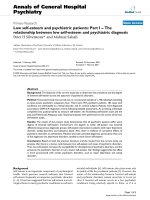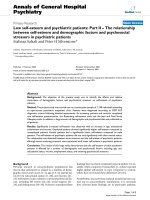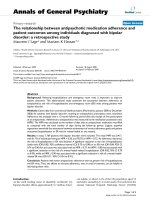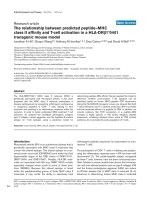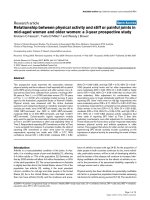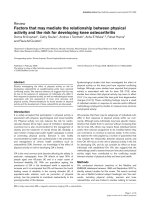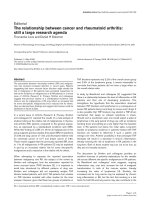Báo cáo y học: "Relationship between psychosomatic complaints and circadian rhythm irregularity assessed by salivary levels of melatonin and growth hormone" ppsx
Bạn đang xem bản rút gọn của tài liệu. Xem và tải ngay bản đầy đủ của tài liệu tại đây (303.22 KB, 6 trang )
RESEARC H Open Access
Relationship between psychosomatic complaints
and circadian rhythm irregularity assessed by
salivary levels of melatonin and growth hormone
Mitsuo Nagane
1*
, Rie Suge
2
and Shu-Ichi Watanabe
2
Abstract
Background: In university health care settings, students with psychosomatic complaints often have chronotypic
problems. For this reason, we investigated a potential connection between psychosomatic complaints and
circadian rhythm irregularity assessed by salivary levels of melatonin and growth hormone.
Methods: Fifteen healthy students between 21 and 22 years of age were examined for physiological parameters of
chronotypes based on melatonin and growth hormone secretion patterns, using a fluorescence enzyme
immunoassay. Salivary samples were collected from subjects at home five times each day (20:00, 24:00, 04:00, 08:00,
and 12:00 h). In addition, the subjects rated their psychosomatic symptoms twice (at 08:00 and 20:00 h).
Results: A group with irregular circadian rhythm of melatonin (ICR) showed more psychosomatic complaints than
a group with the regular circadian rhythm (RCR), especially for anxiety.
Conclusion: Psychosomatic symptoms, particularly anxiety, may be associated with irregularity in melatonin and
growth hormone rhythms, which can be altered by basic lifestyle habits even in healthy students.
Keywords: chronotypes (morningness-eveningness), circadian rhythms, phase difference, healthy students, growth
hormone, melatonin, psychosomatic complaints.
Background
Students suffering from psychoso matic complaints often
have basic lifestyle problems such as short sleep duration
[1] and nocturnal lifestyle [2]. An increasing number of
human health problems are related to dysfunction or
desynchrony of the circadian system [2-4]. Psychosomatic
complaints refer to symptoms experienced by the indivi-
dual with physical symptoms (e.g., head ache) and psycho-
logical symptoms (e.g., irritability). These psychosomatic
symptoms, which are largely mediated by the autonomic
nervous system, may be strongly influenced by an i ndivi-
dual’s lifestyle, and the current so-called “24-h society”
may alter environmental conditions for students.
In a previous study [5], we found that psychosomatic
symptoms may be associated with chronotypic dysfunc-
tion, as inferred from rhythmicity in growth hormone
(GH) levels. The results indicated a relationship between
self-assessment scores and salivary levels of GH: subjects
with high self-assessment scores showed significant
variability in GH secretion over the day, whereas sub-
jects with low self-assessment scores did not. In the pre-
sent study, we focused on circadian dysfunction and
measured both salivary melatonin and GH in each sub-
ject to examine hormone secretion profiles, which may
reflect a subject’s circadian rhythms. Based on these
profiles, we examined whether circadian dysfunction
affects psychosomatic conditions as measur ed by a sim-
ple questionnaire. We sought to uncover an index of
circadian rhythm m odulation and examine the level of
correspondence between hormonal data and an indivi-
dual’s self-rated psychosomatic symptoms.
The circadian pacemaker within the central nervous
system regulates human sleep cycles, hormone secret ion,
subject alertness, objective performance levels, and other
physiological functions over a 24-h period. Core body
temperature, plasma cortisol, and plasma melatonin are
* Correspondence: p
1
Department of Educational Physiology, Faculty of Education, Chiba
University, Japan
Full list of author information is available at the end of the article
Nagane et al. Journal of Circadian Rhythms 2011, 9:9
/>© 2011 Nagane et al; licensee BioMed Central Ltd. This is an Op en Access article distributed under the terms of the Creative Commons
Attribution Lice nse (http://c reativecommons.org/licenses/by/2.0), which p ermits unrestricted use, distribution, and reproduction in
any med ium, provided the or iginal work is properly cited.
three variables that are frequently used to estimate the
phase of the human pacemaker rhythm [6]. The degre e
of a morning or evening chronotype is expressed as a
score that correlates with the timing of an individual’s
sleep, wakefulness, temperature, melatonin, and cortisol
rhythms [7,8]. Syn chronization of endogenous circadian
rhythms to the exogenous 24-h day is thought to be
achieved primarily by light-induced effects o n the circa-
dian clock, as related to the subject’ s activity patterns.
Light is the primary synchronizer of the human biological
rhythm; di ffer ent chronotypes should have different pat-
terns of light exposure depending on individual lifestyles.
A recent study demonstrated the usefulness of salivary
hormone analysis for GH levels [9]. Although evidence
that melatonin plays a role in the regulation of GH
secretion has been reported [10], the relationship
between these hormones and daily lifestyle pattern s
remains poorly understood.
For assessing chronotypes, we used two important hor-
mones, melatonin and GH, which show similar daily
rhythmicity [5,11]. We assumed that t he daily secretion
pattern of melatonin is an important index for examining
the effects of students’ lifestyles on biological rhythms,
because nocturnal melatonin secretion can be suppressed
by exposure to light of several hundred luxes, e.g., ordinary
room light [12], whereas GH is not [13]. As we showed
previously [5], GH is associated with the self assessment of
psychosomatic conditions, and GH insufficiency affects
several psychological conditions, such as reduced vitality
and energy, depressed mood, emotional lability, impaired
self-control, anxiety, and increased social isolation in
adults [14].
The purpose of this research was to explore the lifestyle
of today’s youth by utilizing the characteristics of melato-
nin and GH, both of which show circadian rhythms under
naturalistic conditions. We measured secretion patterns of
melatonin and GH as indices o f a student’sliferhythm
and examined its effect on psychosomatic complaints.
Methods
Participants
Fifteen Japanese university healthy students (7 men and 8
women) ranging in age fro m 21 to 22 years of age and
without major medical disorders participated in this study.
The study design was approved by the Ethics Committee
of Chiba University, Japan, and all subjects provided writ-
ten informed consent. A self-assessment questionnaire
concerning psychosomatic symptoms was developed in
accordance with data from the Health Behaviour in
School-Aged Children study of the WHO [15] and psy-
chosomatic complaints scale for adolescents confirmed by
factor analysis at assessment of validity and reliability of
the scale [16]. T he questionnaire for this study contained
five items related to physical symptoms and five items
pertaining to mental symptoms. The same questionnaire
[5] was used to measure each individual’s psychosomatic
symptoms at home twice each day (08:00 and 20:00 h).
The items were rated on a 4-point scale, with 1 = not true
at all and 4 = completely tr ue. The total score for the
10-item scale ranged from 10 to 40, with higher scores
indicating a greater degree of psycho somatic complaints.
Evening scores were compared with psychosomatic states
in the morning. We assigned subjects to regular or irregu-
lar circadian rhythm groups (RCR and ICR groups, respec-
tively) based on whether melatonin secretion was high
until midnight or not [13].
Sample Collection
Saliva was collected from the subjects’ mouths into Saliv-
ette sampling tubes (Sarstedt, Germany) using polyester
swabs, following 2 min of chewing. Samples were collected
five ti mes each d ay at hom e (20:00, 24:00, 04:00, 08:00, and
12:00 h). To measure the biological rhythms of the stu-
dents’ natural lifestyles, we did not control the timing of
light exposure ( e.g., lights on or off) across the circadian
day. The day of sampling was required to be normal week-
day (i.e., without special events, menstrual periods or
stressful circumstances). They were instructed to keep
usual diurnal rhythm (f or example, meals, bed time and
wake-up time) and to adopt their normal habit of awaken-
ing whether spontaneously or by alarm but to take their
sample immediately upon awakening. During the sleep
phase, subjects were instructed not to turn on the light.
After sample collection, the saliva was stored at -20°C
until use.
Salivary hormone assay
Thesalivasampleswerecentrifugedat3,000rpmfor
10 min to remove all mucin. A standard fluorescent
immunoassay was used to a ssess the salivary melatonin
and growth hormone concentrations in each sample. To
avoid inter-assay variability, all determinations were per-
formed in a single series. In the first step, a 96-well Costar
plate (white polypropylene 3355; Corning, USA) was pre-
coated with 100 μl of anti-melatonin (AB-T079; Advanced
Targeting Systems, USA) and anti-growth hormone anti-
bodies (2071800210; Quartett, Germany) and incubated
for 1.5 h at room temperature. After incubation, the plate
was washed three times with phosphate-buffered saline
and blocked for 1 h. After washing, 100 μl of saliva was
dispensed into each well and left for 1.5 h. After another
washing, primary antibody (35514; Abcam, USA and
FU47500254; Funakoshi, Japan) was added to the plates
and incubated for 1.5 h. Incubation with a secondary
antibody (NB120-7112; Novus Biologicals, USA) was
then performed for 1 h. After washing, rab bit anti-ovine
immunoglobulin (ECF Western blotting reagent pack;
Amersham Biosciences, USA) was added. After 20 min of
Nagane et al. Journal of Circadian Rhythms 2011, 9:9
/>Page 2 of 6
incubation, the plate was scanned using a Fluoromark
microplate fluorometer (Bio-Rad, USA), with excitation at
485 nm and emission at 590 nm.
Statistical analysis
A repeated-measures analysis of vari ance (ANOVA) was
performed on the questionnaire scores [5], to comp are
10 psychosomatic complaints across all subjects (n = 15)
at 08:00 and 20:00 h. Two-way ANOVA (group by time)
with repeated measures (five saliva samples) were calcu-
lated in the parameters’ melatonin or GH incr ease and
post hoc t-test s at each time point was performed to
assess group differences. Next, Pearson’ scorrelation
coefficient was used to test the associations between
melatonin and GH levels. The results were presented as
means ± S.E.M. and the level of significance was set at
.05.
Results
Melatonin and growth hormone secretion profiles
We collected saliva profiles from 15 healthy students (7
men and 8 women). The amplitudes, defined as the differ-
ence between the highest and lowest salivary concentra-
tions, were determined for salivary melatonin and GH and
were used to produce a standardization, or Z score. The
subjects were assigned to regular (RCR; 3 men, 5 women)
or irregular (ICR; 4 men, 3 women) circadian rhythm
groups based on their melatonin rhythms. Figure 1 shows
that, although large individual differences were present in
both groups, melatonin and GH had begun to rise at 24:00
and peaked at 04:00 in the RCR group, whereas no peak in
melatonin or in GH was observed at 24:00 h or 04:00 in
the ICR group. Statistical analyses were performed using a
correlation analysis and analysis of variance (ANOVA) for
repeate d measures. Melatonin rhythms were significantly
correla ted with GH levels in the RCR group (20:00 h, r =
0.90; 24:00 h, r = 0.98; 04:00 h, r = 0.99; 08:00 h, r = 0.89;
12:00 h, r = 0.93; with p < 0.01 for each); however, in the
ICR group, the only significant correlation was at 08:00 h
(r = 0.85, p < 0.05). Furthermore, although there were no
differences in sleep duration between the two groups (RCR
group, mean 6.10 h/day , mean bedtime 01:26 h; ICR
group, mean 6.00 h/day, mean bedtime 02:51 h), sleep/
wake timing was l ater in the ICR group.
As shown in Figure 1, the RCR group differed from
the ICR group in terms of me latonin and GH secretion
rhythms. Salivary melatonin and GH levels in the RCR
group peaked at 04:00 h and reached a minimum at
08:00 h. In contrast, the levels of both hormones in the
ICR group peaked at 08:00 h and were lowest at 04:00
h. Thus, the melatonin profiles differed significantly
between the two groups at 04:00 (t =3.38,df=1,p<
0.01) and 08:00 h (t = -2.15, df = 1, p < 0.05), as did the
GH profiles (t = 2.68, df = 1, p < 0.05 at 04:00 and t =
-2.48, df = 1, p < 0.05, at 08:00 h).
Psychosomatic symptoms profiles
There was a main effect of time across all subjects (p <
0.01), but there was no significant group-by-time inter-
action with respect to psychosomatic symptom profiles.
As shown in Figure 2A and 2B, psychosomatic com-
plaints were high in the morning and decreased in the
evening, especially for drowsiness (F = 40.95, df = 1/29,
p < 0.01), poor appetite (F = 4.44, df = 1/29, p < 0.05),
and whole-body fatigue (F = 5.20, df = 1/29, p < 0.05).
Next, an analysis betwe en the RCR and ICR groups
for each psychosomatic item was performed, revealing a
significant difference in anxiety between the two groups
at 08:00 and 20:00 h (Figure 2A and 2B), with the ICR
M
elatonin
Z-score
4%4ITQWR
+% 4 ITQWR
Growth Hormone
4%4ITQWR
+% 4 ITQWR
Clock Hour
㧖
㧖
㧖㧖
㧖
Figure 1 Daily rhythms of melatonin and growth hormone
secretion in the regular circadian rhythm (RCR, n = 8) group
and irregular circadian rhythm (ICR, n = 7) group. RCR group:
there is a peak in melatonin and growth hormone secretion at
04:00 h. ICR group: there is no peak in melatonin and growth
hormone secretion at 04:00 h. The vertical lines indicate standard
errors of the means (SEM).
Nagane et al. Journal of Circadian Rhythms 2011, 9:9
/>Page 3 of 6
Figure 2 Morning and evening psychosomatic condition scores in the regular circadian rhythm (RCR) and irregular circadian rhythm
(ICR) groups. The scores shown are means and SEM. Each scale ranges from 1 to 4, with a higher score indicating a greater degree of the
psychosomatic symptom (No, Somewhat No, Somewhat Yes, Yes). (A) 8:00 AM; (B) 8:00 PM.
Nagane et al. Journal of Circadian Rhythms 2011, 9:9
/>Page 4 of 6
group showing higher anxiety (F = 9.61, df = 1/29, p <
0.01). There were no significant differences in the oth er
items between the two groups at the 08:00 or 20:00 h
self-assessment.
Discussion
Physiological parameters based on melatonin and growth
hormone rhythms
In this st udy, we devised a new physiological parameter
for assigning c hronotypes based on daily secretion pat-
terns of melatonin as phase marker and GH. We divided
the subjects into two groups, RCR and ICR, based on
whether melatonin secretion was high until midnight.
These two groups showed clear differences in daily secre-
tion patterns (peak points) of GH and in the synchroniza-
tion of the two hormones. As shown in the Results
section, there are significant correlations between mela-
tonin and GH secretion in the RCR group, but not in the
ICR group (excluding 08:00 h). In contrast to the RCR
group, the ICR group did not exhibit a characteristic pro-
file for melatonin and GH, as there was no sharp peak
typical of a normal profile [17,18]. Based on our recent
results suggesting that GH and melatonin show similar
secretion rhythms [11], we hypothesize that an indivi-
dual’s circadian rhythm can be more exactly determined
by analyzing melatonin and GH as a pair. Therefore, we
suggest that the asynchronicity and lack of peak secretion
for the two hormones reflect an irregular circadian
rhythm.
Chronotypes and psychosomatic symptoms
It has been reported that morning chronotypes tend to
perform well early in the day, while evening chronotypes
show enhanced performance later in the day [19]. Some
research reports that evening chronotypes go to bed later
than midnight, but do not show signs of significantly
short sleep duration because they also rise later in the
morning. Furthermore, evening chronotypes omit break-
fast,butconsumeadequateenergybecausetheyeat
much more at night [17].
Evening chronotypes report psychological and psycho-
somatic distu rbances more frequently and intensively
than morning chronotypes, who tend to have a healthier
lifestyle [20]. In our research during normal weekday
under naturalistic conditions, the ICR group tended to
more frequently complain of negative psychosomatic
conditions, including feeling anxious (p < 0.01 compared
with RCR).
In the present study, the circadian rhythm profiles of
salivary melatonin and GH in the ICR group exhibited
broad peaks that shifted towards the morning, as com-
pared with the RCR group. It has been reported that peak
hormonal secretion often shifts to the morning when an
activity continues long into the night [13,21]. We
hypothesize that psychosomatic states in the morning are
deeply reflective of hormonal secretion. Therefore, morn-
ing psychosomatic state may be associated with lifestyle.
That is, we hypothesize this psychosomatic disturbances
fundamentally originate in phase and amplitude differ-
ences of circadian rhythm.
Chronotypes and anxiety
Assessments of psychosomatic health complaints in
European students show that the highest rates of com-
plaints are found for physical states such as backache,
headache, and neck ache [22], in addition to nervous-
ness and irritability [15]. However, a survey of Japanes e
high school students indicates that psychological items
related to attentiveness, depressive state, and irrit ability
are more often affec ted. For chronotypes in Japanese
students, increases in psychological stresses [16] related
to anxiety are likely to have multiple causes.
It has been suggested that Japanese students suffering
from psychosomatic disorders such as those involving
mood and sleep may exhibit basic lifestyle problems,
including deleterious changes in their living environment
and dietary or lifestyle disturbances [2]. In particular,
staying up la te is associated with decreased appetite and
missed breakfast the following morning, irregular bowel
movements, and sleepiness. In our research, p hysical
complaints such as those observed in European students
were rather low, and differences between our groups
were only observed for anxiety. Assuming that t he ICR
group reflects problems due to irre gular lifestyle, our
results are consistent with diff erences observed between
European and Japanese students with respect to psycho-
somatic complaints reported thus far.
Our results indicate a relationship between melatonin
and GH levels and self-assessment score s, exclusively
anxiety. In contrast to subjects in the RCR group, sub-
jects in the ICR group tended to feel anxiety not only in
the morning but also in the evening, although both
groups had high anxiety scores. Anxiety in Japanese
youth related to basic lifestyle habits may be associated
with hormonal rhythms. The present research revealed
tha t nocturnal lifestyle in students increased their risk of
psychosomatic health problems, including anxiety.
Limitations
In this study, we attempted to clarify the association
between psychosomatic symptoms and melatonin and
GH levels; however, our study has limitations. First, the
number of subjects st udie s was relatively small. Second,
the sleep-disrupting effect of waking at 24.00 h and 04.00
h to produce a saliva sample might have influenced hor-
mone secretion. Third, in spite of our attempt to avoid
menstrual cycle problems, gender differences may have
influenced the results.
Nagane et al. Journal of Circadian Rhythms 2011, 9:9
/>Page 5 of 6
Conclusion
Our results suggest that psychosomatic symptoms, parti-
cularly anxiety, may be associated with melatonin and
growth hormone rhythms, which are a direct result of
basic lifestyle habits, even in healthy students. We propose
that physiological analyses of a student’s circadian rhythm
should include measurements of melatonin and GH secre-
tion as phase markers. We believe it is important to focus
our attention on student’s basic lifestyle problems, as an
irregular biological rhythm may increase the prevalence of
psychosomatic complaints.
Acknowledgements
This research was supported by a Grant-in-Aid for Scientific Research (C) No.
20500594 from the Japanese Ministry of Education to Nagane M.
Author details
1
Department of Educational Physiology, Faculty of Education, Chiba
University, Japan.
2
Department of Physiology, Faculty of Medicine, Saitama
Medical University, Japan.
Authors’ contributions
MN designed the experiments, collected data and wrote the manuscript. RS
participated in the design of this study and analyzed data. SW managed the
laboratory and participated in the analysis and discussion of the results. All
authors read and approved the manuscript.
Competing interests
The authors report no conflicts of interest. The authors alone are responsible
for the content and writing of this paper.
Received: 7 May 2011 Accepted: 14 September 2011
Published: 14 September 2011
References
1. Steptoe A, Peacey V, Wardle J: Sleep duration and health in young adults.
Arch Intern Med 2006, 166:1689-1692.
2. Okamoto M, Tan F, Suyama A, Okada H, Miyamoto T, Kishimoto T: The
characteristics of fatigue symptoms and their association with the life
style and the health status in school children. J Epidemiol 2000,
10:241-248.
3. Harada T: Effects of evening light conditions on salivary melatonin of
Japanese junior high school students. J Circadian Rhythms 2004, 2:4.
4. Randler C: Morningness-eveningness comparison in adolescents from
different countries around the world. Chronobiol Int 2008, 25:1017-1028.
5. Nagane M, Yoshimura K, Watanabe S, Nomura M: A possible connection
between psychosomatic symptoms and daily rhythmicity in growth
hormone secretion in healthy Japanese students. J Circadian Rhythms
2009, 7:10.
6. Klerman EB, Gershengorn HB, Duffy JF, Kronauer RE: Comparisons of the
variability of three markers of the human circadian pacemaker. J Biol
Rhythms 2002, 17:181-193.
7. Bailey SL, Heitkemper MM: Circadian rhythmicity of cortisol and body
temperature: morningness-eveningness effects. Chronobiol Int 2001,
18:249-261.
8. Roenneberg T, Kuehnle T, Juda M, Kantermann T, Allebrandt K, Gordijn M,
Merrow M: Epidemiology of the human circadian clock. Sleep Med Rev
2007, 11:429-438.
9. Chiappin S, Antonelli G, Gatti R, De Palo EF: Saliva specimen: a new
laboratory tool for diagnostic and basic investigation. Clin Chim Acta
2007, 383:30-40.
10. Valcavi R, Zini M, Maestroni GJ, Conti A, Portioli I: Melatonin stimulates
growth hormone secretion through pathways other than the growth
hormone-releasing hormone. Clin Endocrinol (Oxf) 1993, 39:193-199.
11. Nagane M, Yoshimura k, Watanabe S-I, Nomura M: Examination of the
validity of growth hormone as an index of the biological rhythm in
comparison with cortisol and melatonin in Japanese healthy students.
J Physiol Sci 58(Suppl) 2008, S87.
12. Aoki H, Yamada N, Ozeki Y, Yamane H, Kato N: Minimum light intensity
required to suppress nocturnal melatonin concentration in human
saliva. Neurosci Lett 1998, 252:91-94.
13. Kostoglou-Athanassiou I, Treacher DF, Wheeler MJ, Forsling ML: Bright light
exposure and pituitary hormone secretion. Clin Endocrinol (Oxf) 1998,
48:73-79.
14. Carroll PV, Christ ER, Bengtsson BA, Carlsson L, Christiansen JS,
Clemmons D, Hintz R, Ho K, Laron Z, Sizonenko P, Sonksen PH, Tanaka T,
Thorner M: Growth hormone deficiency in adulthood and the effects of
growth hormone replacement: a review. Growth Hormone Research
Society Scientific Committee. J Clin Endocrinol Metab 1998, 83:382-395.
15. Haugland S, Wold B, Stevenson J, Aaroe LE, Woynarowska B:
Subjective
health complaints in adolescence. A cross-national comparison of
prevalence and dimensionality. Eur J Public Health 2001, 11:4-10.
16. Takata Y, Sakata Y: Development of a psychosomatic complaints scale for
adolescents. Psychiatry Clin Neurosci 2004, 58:3-7.
17. Qin LQ, Li J, Wang Y, Wang J, Xu JY, Kaneko T: The effects of nocturnal life
on endocrine circadian patterns in healthy adults. Life Sci 2003,
73:2467-2475.
18. Van Cauter E, Leproult R, Plat L: Age-related changes in slow wave sleep
and REM sleep and relationship with growth hormone and cortisol
levels in healthy men. JAMA 2000, 284:861-868.
19. Matchock RL, Mordkoff JT: Chronotype and time-of-day influences on the
alerting, orienting, and executive components of attention. Exp Brain Res
2009, 192:189-198.
20. Randler C: Morningness-Eveningness and Satisfaction with Life. Social
Indicators Research 2008, 86:297-302.
21. Arendt J: Importance and relevance of melatonin to human biological
rhythms. J Neuroendocrinol 2003, 15:427-431.
22. Stock C, Kucuk N, Miseviciene I, Guillen-Grima F, Petkeviciene J, Aguinaga-
Ontoso I, Kramer A: Differences in health complaints among university
students from three European countries. Prev Med 2003, 37:535-543.
doi:10.1186/1740-3391-9-9
Cite this article as: Nagane et al.: Relationship between psychosomatic
complaints and circadian rhythm irregularity assessed by salivary levels
of melatonin and growth hormone. Journal of Circadian Rhythms 2011
9:9.
Submit your next manuscript to BioMed Central
and take full advantage of:
• Convenient online submission
• Thorough peer review
• No space constraints or color figure charges
• Immediate publication on acceptance
• Inclusion in PubMed, CAS, Scopus and Google Scholar
• Research which is freely available for redistribution
Submit your manuscript at
www.biomedcentral.com/submit
Nagane et al. Journal of Circadian Rhythms 2011, 9:9
/>Page 6 of 6

